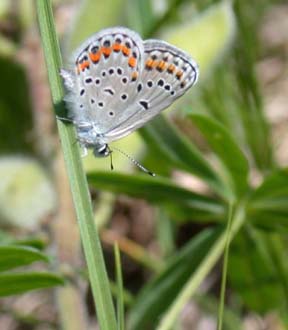Reproduction
Similar to other
butterflies the Karner blue has four life cycle stages including egg, larva
(caterpillar), pupa (chrysalis), and adult (butterfly) (Lycaeides
melissa samuelis 2010). This cycle occurs twice a year producing two
broods or generations each year. The first brood appear in late May to
mid-July and the second brood survive through the winter to appear the
following May (Department of Environmental Conservation 2013).
The cycle begins with
Females laying eggs on the underside of a leaf or stem of wild lupine
plants (Lupinus perennis). These eggs are strategically laid here because once they hatch into
larvae the wild lupine is their only food source at that stage (ehow 2013).
The eggs hatch and become larvae within 7-8 days (Department of
Environmental Conservation 2013). The larvae (caterpillars) then feed on the
wild lupine eating multiple times their weight in leaves (Weiner, J 1983).
For three weeks these larvae eat large amounts and grow through five larval
stages until it reaches its chrysalis stage. During the chrysalis stage the
larva self covers with a hard encasing in which it hangs for about a week
from the leaf of the wild blue lupine. The adult butterfly then emerges to
dry its wings and begin the cycle again with the laying of eggs (Weiner,J
1983).
The cycle of brood
alternation within a year is as follows: The first brood eggs hatch into
larvae and feed on wild lupine for three to four weeks until chrysalis. Next
the first brood adults emerge from chrysalis into adult butterflies during
mid-May to June. Those adult butterflies then lay eggs which hatch into the
second brood within five to ten days. The second brood larvae feed on the
wild blue lupine for three to four weeks before also moving into the
chrysalis stage. The second brood emerges from chrysalis into adults in
early July. The second brood adults then lay their eggs (oviposit). These
eggs survive through winter and hatch the following April into what is
considered the first brood. The cycle then begins again. (Pickens, B.A. and
K.V. Root 2008).
It has been found that
the two alternating broods have different ovipositing (or egg lying)
tendencies. This can be explained by the different environmental factors
influencing the two broods. Dry conditions are common for the second brood
during the larva stage which causes decreased leaf water and nitrogen levels
in the host plant (wild lupine). This may result in increased morality rates of larvae as
well as poor physical conditions of the adults of the second brood. These
environmental factors likely cause the differences in ovipositing which
included the first brood only laying eggs on wild lupines whereas the later
brood was observed to lay eggs on grasses, dewberry, early goldenrod, and on
the ground in addition to lying them on wild lupine. It was not only
observed that the broods differ in ovipositing location, but also in
frequency and method of ovipositing. The first brood was noticed to ovipost
more often than the second; however the second brood was more likely to
choose more locations to ovipost. The first brood was noticed to ovipost
multiple eggs in a cluster or bunch whereas the second brood most often
spread out their eggs in different areas (Pickens, B.A. and K.V. Root 2008).
Though the location,
frequency, and methods of ovipositing differed between broods, research
showed that the amount of eggs produced and laid were similar between the
two. This study proved that though old research argued population
growth rates of the karner blue were more density-dependent on large egg
production of the first brood of Karner blue adults, this simply is not
true. When comparing the productivity of the two broods it was found that
the differences were not due to number of eggs in oviducts of the adults but
instead the limited time for oviposition due to environmental conditions
(Pickens, B.A. and K.V. Root 2008).
Click here to go back to the homepage.
